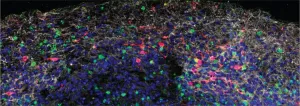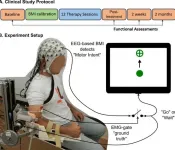SARS-CoV-2 can infect neurons and damage brain tissue, study indicates
2021-01-12
(Press-News.org) Using both mouse and human brain tissue, researchers at Yale School of Medicine have discovered that SARS-CoV-2 can directly infect the central nervous system and have begun to unravel some of the virus's effects on brain cells. The study, published today in the Journal of Experimental Medicine (JEM), may help researchers develop treatments for the various neurological symptoms associated with COVID-19.
Though COVID-19 is considered to primarily be a respiratory disease, SARS-CoV-2 can affect many other organs in the body, including, in some patients, the central nervous system, where infection is associated with a variety of symptoms ranging from headaches and loss of taste and smell to impaired consciousness, delirium, strokes, and cerebral hemorrhage.
"Understanding the full extent of viral invasion is crucial to treating patients, as we begin to try to figure out the long-term consequences of COVID-19, many of which are predicted to involve the central nervous system," says Akiko Iwasaki, a professor at Yale School of Medicine.
Many questions remain to be answered, including whether SARS-CoV-2 can infect neurons or other types of brain cells. To address this question, a team led by Iwasaki and co-senior author Kaya Bilguvar, an associate professor at Yale School of Medicine, analyzed the ability of SARS-CoV-2 to invade human brain organoids, miniature 3D organs grown in the lab from human stem cells. The researchers found that the virus was able to infect neurons in these organoids and use the neuronal cell machinery to replicate. The virus appears to facilitate its replication by boosting the metabolism of infected cells, while neighboring, uninfected neurons die as their oxygen supply is reduced.
SARS-CoV-2 enters lung cells by binding to a protein called ACE2, but whether this protein is present on the surface of brain cells is unclear. The Yale team determined that the ACE2 protein is, in fact, produced by neurons and that blocking this protein prevents the virus from human brain organoids.
SARS-CoV-2 was also able to infect the brains of mice genetically engineered to produce human ACE2, causing dramatic alterations in the brain's blood vessels that could potentially disrupt the organ's oxygen supply. Central nervous system infection was much more lethal in mice than infections limited to the lungs, the researchers found.
Finally, the researchers analyzed the brains of three patients who succumbed to COVID-19. SARS-CoV-2 was detected in the cortical neurons of one of these patients, and the infected brain regions were associated with ischemic infarcts in which decreased blood supply causes localized tissue damage and cell death. Microinfarcts were detected in the brain autopsy of all three patients.
"Our study clearly demonstrates that neurons can become a target of SARS-CoV-2 infection, with devastating consequences of localized ischemia in the brain and cell death," Bilguvar says. "Our results suggest that neurologic symptoms associated with COVID-19 may be related to these consequences, and may help guide rational approaches to the treatment of COVID-19 patients with neuronal disorders."
"Future studies will be needed to investigate what might predispose some patients to infections of the central nervous system and to determine the route of SARS-CoV-2 invasion into the brain and the sequence of infection in different cell types within the central nervous system that will help validate the temporal relationship between SARS-CoV-2 and ischemic infarcts in patients," Iwasaki adds.
INFORMATION:
Song et al., 2021. J. Exp. Med. https://rupress.org/jem/article-lookup/doi/10.1084/jem.20202135?PR
About the Journal of Experimental Medicine
The Journal of Experimental Medicine (JEM) features peer-reviewed research on immunology, cancer biology, stem cell biology, microbial pathogenesis, vascular biology, and neurobiology. All editorial decisions are made by research-active scientists in conjunction with in-house scientific editors. JEM makes all of its content free online no later than six months after publication. Established in 1896, JEM is published by the Rockefeller University Press. For more information, visit jem.org.
Visit our Newsroom, and sign up for a weekly preview of articles to be published. Embargoed media alerts are for journalists only.
Follow JEM on Twitter at @JExpMed and @RockUPress.
[Attachments] See images for this press release:

ELSE PRESS RELEASES FROM THIS DATE:
2021-01-12
The first step in treating cancer is understanding how it starts, grows and spreads throughout the body. A relatively new cancer research approach is the study of metabolites, the products of different steps in cancer cell metabolism, and how those substances interact.
To date, research like this has focused mostly on cancerous tissues; however, normal tissues that surround tumors, known as the extratumoral microenvironment (EM), may have conditions favorable for tumor formation and should also be studied.
In a new study published in the journal PLOS ONE, researchers investigated the metabolites involved in the growth and spread of melanoma, a rare but deadly ...
2021-01-12
Almost 18,000 Americans experience traumatic spinal cord injuries every year. Many of these people are unable to use their hands and arms and can't do everyday tasks such as eating, grooming or drinking water without help.
Using physical therapy combined with a noninvasive method of stimulating nerve cells in the spinal cord, University of Washington researchers helped six Seattle area participants regain some hand and arm mobility. That increased mobility lasted at least three to six months after treatment had ended. The research team published these findings Jan. 5 in the journal ...
2021-01-12
A recent study finds that, in the wake of a mass shooting, National Rifle Association (NRA) employees, donors and volunteers had extremely mixed emotions about the organization - reporting higher levels of both positive and negative feelings about the NRA, as compared to people with no NRA affiliation.
"We wanted to see what effect 'in-group' affiliation and political identity had on how people responded to the NRA's actions after a mass shooting," says Yang Cheng, co-author of the study and an assistant professor of communication at North Carolina State University. "The political findings were predictable - Republicans thought more favorably of the NRA than Democrats did. But the in-group affiliation was a lot more complex than ...
2021-01-12
Stroke survivors who had ceased to benefit from conventional rehabilitation gained clinically significant arm movement and control by using an external robotic device powered by the patients' own brains.
The results of the clinical trial were described in the journal NeuroImage: Clinical.
Jose Luis Contreras-Vidal, director of the Non-Invasive Brain Machine Interface Systems Laboratory at the University of Houston, said testing showed most patients retained the benefits for at least two months after the therapy sessions ended, suggesting the potential for long-lasting gains. He is also Hugh Roy and Lillie Cranz Cullen Distinguished Professor of electrical and computer engineering.
The trial involved training stroke survivors with limited movement in one arm to use a brain-machine interface ...
2021-01-12
GAINESVILLE, Fla. --- Entomologist Akito Kawahara's message is straightforward: We can't live without insects. They're in trouble. And there's something all of us can do to help.
Kawahara's research has primarily focused on answering fundamental questions about moth and butterfly evolution. But he's increasingly haunted by studies that sound the alarm about plummeting insect numbers and diversity.
Kawahara has witnessed the loss himself. As a child, he collected insects with his father every weekend, often traveling to a famous oak outside Tokyo ...
2021-01-12
MANHATTAN, KANSAS -- Kyle Goerl, the medical director of Kansas State University's Lafene Health Center, is part of a collaborative team that is providing research-based guidance during the COVID-19 pandemic. The team's latest research contributed to the updated quarantine guidance from the Centers for Disease Control and Prevention.
Goerl is a co-author of the publication "Time from Start of Quarantine to SARS-CoV-2 Positive Test Among Quarantined College and University Athletes." The publication appeared in the Morbidity and Mortality Weekly Report from the CDC on Friday, Jan. 8, and involved researchers from multiple organizations and universities.
The publication was one of many that the ...
2021-01-12
Osaka, Japan -- Ultra-intense lasers with ultra-short pulses and ultra-high energies are powerful tools for exploring unknowns in physics, cosmology, material science, etc. With the help of the famous technology "Chirped Pulse Amplification (CPA)" (2018 Nobel Prize in Physics), the current record has reached 10 Petawatts (or 10^16 Watts). In a study recently published in Scientific Reports, researchers from Osaka University proposed a concept for next-generation ultra-intense lasers with a simulated peak power up to the Exawatt class (1 Exawatt equals 1000 Petawatts).
The laser, which was invented by Dr. T. H. Maiman in 1960, has one important characteristic of high intensity (or high peak power for pulse lasers): historically, laser peak ...
2021-01-12
Scientists at Nanyang Technological University, Singapore (NTU Singapore) have developed insulin nanoparticles that may one day become the basis for an oral medicine, and an alternative to insulin injections for diabetic patients.
In a pre-clinical study, the NTU Singapore team fed insulin-containing nanoparticles to rats and found that insulin increased in their blood minutes later.
Insulin therapy is often an important part of treatment for diabetes, a metabolic disease that affects 422 million people globally . In Singapore, the number of diabetics is expected to grow to 1 million - almost a fifth of the population - in 2050 .
Delivering insulin orally would be preferable over insulin jabs for patients because it causes less ...
2021-01-12
Anthropogenic, or human-made, heat flux in the near-surface atmosphere has changed urban thermal environments. Much of this fluctuation has been noted with rapid development of the global economy and urbanization since the turn of the 21st century. Meanwhile, the number of extreme temperature events in the first decade of the 21st century grew faster than in the last 10 years of the 20th century. During this period, urban extreme heat events have become more frequent, breaking temperature records more often.
"We found the relationships between anthropogenic heat flux and extreme temperature events..." said Prof. Zhenghui Xie, a scientist with the Institute of Atmospheric Physics, Chinese Academy of Sciences. "...including ...
2021-01-12
DALLAS - Jan. 12, 2021 - A team of UT Southwestern researchers has identified a gene involved in the growth of breast cancer, a finding that could lead to potential new targets for treatment.
"The gene ZMYND8 is increased in breast cancer conditions, and higher levels of the gene correlate with poor survival of breast cancer patients," says Yingfei Wang, Ph.D., assistant professor of pathology and neurology and corresponding author of the new study, published in Cancer Research. "It could be a promising target for antitumor immunotherapy."
In the U.S., about 1 in 8 women will develop breast cancer at some point in their life. Worldwide, breast cancer is the most common cancer ...
LAST 30 PRESS RELEASES:
[Press-News.org] SARS-CoV-2 can infect neurons and damage brain tissue, study indicates






